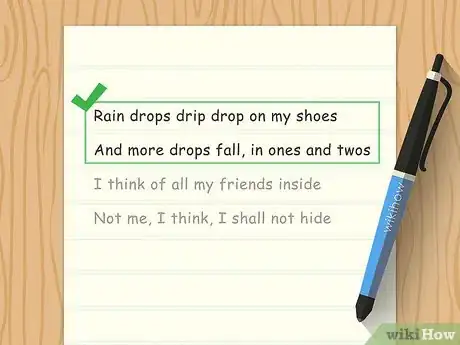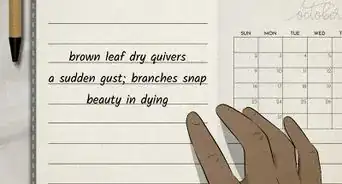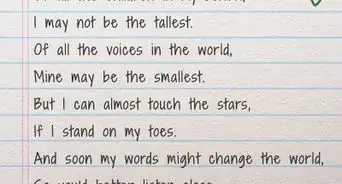This article was co-authored by Alicia Cook. Alicia Cook is a Professional Writer based in Newark, New Jersey. With over 12 years of experience, Alicia specializes in poetry and uses her platform to advocate for families affected by addiction and to fight for breaking the stigma against addiction and mental illness. She holds a BA in English and Journalism from Georgian Court University and an MBA from Saint Peter’s University. Alicia is a bestselling poet with Andrews McMeel Publishing and her work has been featured in numerous media outlets including the NY Post, CNN, USA Today, the HuffPost, the LA Times, American Songwriter Magazine, and Bustle. She was named by Teen Vogue as one of the 10 social media poets to know and her poetry mixtape, “Stuff I’ve Been Feeling Lately” was a finalist in the 2016 Goodreads Choice Awards.
There are 10 references cited in this article, which can be found at the bottom of the page.
This article has been viewed 308,377 times.
When we think of 'poetry', we usually think of poetry that rhymes. But there are many other styles of poetry, and each one is unique. An acrostic is a particular type of poem that does not necessarily have to rhyme. This article will teach you what an acrostic is and how to write a good one.
Steps
Pre-Writing for Your Acrostic Poem
-
1Decide what materials to use. Some people may want to write on a computer, whereas others work better with pencil and paper. There are pros and cons to each, so think about which way will work better for you. If you’re not sure, you can try each method and see which feels more comfortable to you.
- A computer will let you erase and edit more easily, and also let you undo mistakes and save alternate drafts with ease.
- Pencil and paper makes you slow down and really think about what you’re writing on the page. Studies have also shown that writing by hand strengthens the brain.[1]
-
2Understand how acrostics work. Acrostics may sound complicated, but they’re really not! All you need to remember is that the first letter of each line, when read vertically, must spell out the topic of the poem. The topic is often a single word, but can be more than that if you’d like. Consider this example of an acrostic poem about the sun.
- Keep in mind that the word you choose to serve as the first letter of each line will determine the length of your acrostic. Choose a word that corresponds with the length you want to write.
- If the word you want to write about is too long or too short, consult a thesaurus for synonyms. For example, if “love” is too short, you might try “friendship,” “adoration,” “devotion,” “tenderness,” etc.
- Remember that you can also use multiple words for your subject if you’d like. This is an easy way to add length.
Advertisement -
3Brainstorm.[2] What do you want to write about? Choose a subject that you have a lot to say about, and hopefully one that gives you the opportunity to use your writing chops with sensory imagery and inventive language. Some helpful brainstorming activities might include:
- Keeping an ongoing notebook where you keep track of things you want to write about
- Making lists of the characteristics of the thing you want to write about. For example: your mother’s personality, her appearance, your favorite memory of her, how her voice sounds, what her perfume smells like, etc.
- Taking a walk and making notes about what you see in your notebook
- Taking inspiration from a piece of art. How does your favorite song or painting make you feel?
- Write about yourself! Who do you know better than yourself?
Writing Your Acrostic Poem
-
1Write your subject word vertically. Since each line must begin with a letter from your subject word, you should always start by writing out the word. This way, you can visualize the poem and start anticipating how your lines are going to come together.
- Usually, the first letter of each line is capitalized, so it’s easier to see the word that’s spelled out.[3]
-
2Fill in the lines of your poem.[4] You might be tempted to start with the first line, but you don’t have to. Look at all the letters you have to work with. What’s the most interesting line you can think of that starts with one of those letters? Begin there, so you know you have at least one line that you absolutely love!
-
3Focus on sensory imagery.[7] Sensory imagery is language that draws on the five senses: sight, sound, touch, taste, and smell. Your reader will be able to understand abstract concepts like “love” or “hope” better if they can imagine specific details through their bodies.
- For example, instead of saying you love your mother, you can say you love the way she smells like onions when she’s done cooking dinner.
-
4Try using similes and metaphors. A simile is a comparison that uses the words “like” or “as”: as red as a rose. A metaphor makes a comparison, too, but instead of saying that one thing is “like” another, it goes a step further and says that the two things being compared are the same thing: the clouds were cotton balls in the sky.[8]
-
5Use inventive language. Avoid cliches (sayings that have become so common that everybody knows them).[9] Examples include calling something “red as a rose” or comparing clouds to cotton balls. Instead, be as creative as possible! Try to come up with descriptions, images, and comparisons that you’ve never heard before.
-
6Revise your poem. Just because you finished filling out the lines of your acrostic doesn’t mean you’re done yet! Once you’ve finished your first draft, read it back to yourself and think about how you can make it even better.
- Make abstract language more concrete.[10] Abstract language like “hope” and “love” might sound pretty, but it doesn’t say as much as language that we can feel in the body through sensory imagery.
- Strengthen your word choice. Circle all the words that look like they could be more interesting. Look up synonyms in the thesaurus to make your language pop, but don't choose a word just because it's long.
- Stay on topic. Make sure every line of the poem goes toward saying something about your subject.
-
7Edit your acrostic for grammar and spelling. After you’ve made the poem as interesting and creative as possible, you need to go back and edit for mechanical errors. Make sure your reader can understand your poem by clearing up any confusing, awkward language. This should always be the very last thing you do.
Sample Acrostic Poem
Community Q&A
-
QuestionHow do I write an acrostic poem from "appreciation"?
 Fatima WarraichCommunity AnswerThink about what "appreciation" means to you. Note down words that are synonymous to appreciation or are linked to it. Then, pick specific ideas and put them together. Next, edit your writing and make it better. Remember to use figurative language.
Fatima WarraichCommunity AnswerThink about what "appreciation" means to you. Note down words that are synonymous to appreciation or are linked to it. Then, pick specific ideas and put them together. Next, edit your writing and make it better. Remember to use figurative language. -
QuestionHow do I write an acrostic poem with someone's name as the subject? What content should I put in?
 Community AnswerThink of all of the things you like about them and their good qualities. Write them down and see if you can fit those ideas in your poem.
Community AnswerThink of all of the things you like about them and their good qualities. Write them down and see if you can fit those ideas in your poem. -
QuestionCan I put a period in an acrostic poem?
 Community AnswerNo, but you can add commas if you want to.
Community AnswerNo, but you can add commas if you want to.
References
- ↑ http://www.huffingtonpost.com/2014/09/12/writing-on-paper_n_5797506.html
- ↑ https://www.artgallery.umd.edu/sites/artgallery.umd.edu/files/lesson-plans/Brainstorming%20Worksheet%20-%20Poem%20-%20Poetic%20Aesthetic.pdf
- ↑ https://www.bbc.co.uk/bitesize/topics/z4mmn39/articles/ztdvw6f
- ↑ https://poetry4kids.com/lessons/how-to-write-an-acrostic-poem/
- ↑ https://liberalarts.oregonstate.edu/wlf/what-enjambment
- ↑ https://online.maryville.edu/online-bachelors-degrees/online-literary-devices-guide/
- ↑ https://www.poetryfoundation.org/articles/70049/writing-from-the-senses/
- ↑ https://owl.purdue.edu/owl/subject_specific_writing/writing_in_literature/literary_terms/index.html
- ↑ https://www.csusm.edu/writingcenter/writing/style.html#Cliches









































































